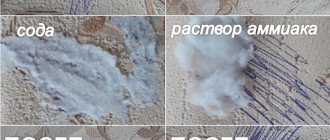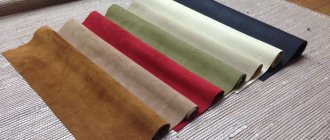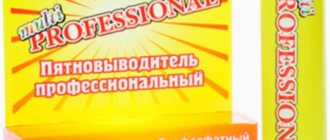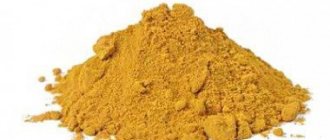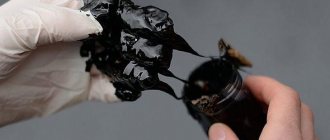How to clean real fur
Sometimes it is enough to get rid of dust and comb your fur clothes to refresh them. Here's how to refresh mink, arctic fox or silver fox fur:
- Wrap the fur coat in slightly damp cotton cloth.
- Place on a flat surface and knock out on all sides.
- Shake the fur coat, hang it on a hanger and comb it with a special brush.
If you notice that the pile has become wrinkled and has lost its color, fluffiness and shine, then it’s time to clean the fur. Use effective cleaning methods for the specific type of fur.
Rules for caring for fur coats
- Do not wash the product yourself. Take it to the dry cleaner if it gets really dirty, or remove stains using other methods.
- Use wide hangers. This will help avoid deformation of the lining and prevent sagging.
- When storing, avoid bright light and direct sunlight. From them, the fur deteriorates and loses its former attractiveness.
- When putting your fur coat in the closet, give it more free space. The product requires space. If the item does not come into contact with other items of clothing, the likelihood of “orange” will decrease.
- Do not put the product in a plastic case, otherwise it will smell. For storage, use a closed dark case. For a white mink, purchase a blue cover: this will prevent the fur from turning yellow.
- Air your fur coat periodically. Hang outdoors in cool weather and then dry indoors.
- Use anti-moth products. Change every summer
- Comb products with long pile periodically.
- If the fur is wet after snow or rain, dry it. Hang on hangers and let dry. Do not place near the battery.
- Do not apply perfume to the pile - it negatively affects the condition of the fur. Spray perfume onto the lining.
- Use special tools and read the instructions carefully.
The article has been verified by the editors
How to clean faux fur
With proper care, high-quality faux fur can look no less luxurious than natural fur. How to clean fur? Here are some simple but effective cleaning options:
- Hydrogen peroxide. Add 30 ml of peroxide to 0.5 liters of water. Pour into a spray bottle and spray onto fur. After it dries, comb the fur item with a comb.
- Starch. Pour the powdery substance onto your fur coat and rub it in with a paper towel or piece of soft cloth. Vacuum the fur or give it a good beating.
- Soda. Rub the powder into the pile with a piece of cloth or sponge and remove with a brush. Repeat the procedure until the soda is snow-white.
Why does fur have an unpleasant odor?
First you need to find out the cause of this aromatic blockage.
Often you simply stored your fur coat incorrectly in the wrong packaging. Where do bulky items go after winter wear? We know where: in a plastic bag, but it doesn’t let in a drop of air. So the air gap between the pile stagnates; stale air does not in any way contribute to the freshness of the furs. You take out your fur coat to put it on, and it greets you in such a way that you want to turn away from it and hold your nose.
First of all, change the plastic bag on your fur coat to a fabric one. And you don’t need to “shove” the fur coat there, but carefully “pull” it into the cover, straightening the fur. Air should circulate freely through the pile.
How to clean dark colored fur
Dark fur is beautiful and practical, but it should also be cleaned from time to time. How? Take advantage of practical advice.
Natural dark mink coat: YouTube/Household Recipes
Absorbents for cleaning
Simple and affordable products that have absorbent properties will help you clean a dark-colored fur coat:
- Sawdust. Use sawdust from deciduous trees only. Coniferous wood contains resins that damage the product.
- Sand. Warm sand cleans beaver, mink, and rabbit fur well.
- Rye bran. Coarse pile (wolf, goat or nutria fur) should be cleaned with this product.
Features when cleaning different types of fur
To clean light fur from both dirt and yellowness, you can use the following methods:
- You need to prepare a mixture of vinegar, alcohol and water in equal proportions.
The solution is applied to the item using a special brush or soft sponge. After the procedure, you need to wipe the product with a dry cloth. Starch - First, starch is poured in, then it is sprayed with soapy water (you can use powder for delicate fabrics or shampoo). You should get a thick paste that you rub with your hands all over the item. After drying, the powder is brushed off and the fur is shaken to remove any remaining product.
- Dilute 1 tsp in 250 ml of water. hydrogen peroxide and a couple of drops of ammonia. The solution should be poured into a spray bottle and treated with the product, then left to dry.
- Bran also helps get rid of yellowness: you need to heat the product in a dry frying pan, scatter it and distribute it along the entire length of the pile. After some time they need to be removed.
White fur looks especially luxurious, but care must be taken to ensure that its color does not fade or turn yellow. Such a fur coat must be protected from moths, dryness and moisture, and street dirt. To prevent it from turning yellow ahead of time, you should not spray perfume on it, or store it near a battery. Please note that it is also not recommended to turn on the seats in the car.
The most problematic areas of a light fur coat are the cuffs, pockets and shoulders. The fur in these areas turns yellow and stretches due to jewelry and heavy bags. In addition, the collar gets dirty easily, especially for women, since many wear makeup.
To remove yellowness, you can use a mixture of starch and gasoline. First, you need to mix them to a thick paste, apply them to a brush or rag and treat the problem area. As soon as the product dries, you need to shake off the starch and ventilate the product.
The recipe helps both refresh light fur and remove traces of yellowness, greasy stains and foundation residues.
Caring for a fur coat is quite difficult, but the effort pays off in comfort, luxurious appearance and warmth in harsh winters. Since it is impossible to clean fur with strong detergents, and it can easily be damaged, it is recommended to take the product to a reputable dry cleaner. In addition, you should remember the basic rules for storing fur items in the off-season so that they last a long time.
To wash fur, you need to know which methods are suitable for a specific shade of the product in order to reduce the risk of damage to the product to zero. To do this, you should familiarize yourself with the list of prohibited products.
Exposure to dry compounds is an effective way to clean fur from dust:
- For dark fur, acceptable absorbents are hot sand, rye bran, sawdust and ground walnut shells. They remove dust and dirt from the pile, improving its appearance.
- For white products, cleaning with sand and walnut shells is fraught with staining, so preference should be given to starch, semolina and talc. Talc not only copes with the assigned cleaning tasks, but also neutralizes unpleasant odors.
- It is worth saying that talc is not recommended for dark fur. Small grains can settle on the hairs, which will lead to loss of shine, luster and natural color.
We invite you to familiarize yourself with all the secrets of caring for nubuck shoes
Watch the video on how to clean natural fur yourself.
Wet exposure is only permissible superficially, without affecting the interior. Light damp cleaning will help neutralize the oily sheen of dark fur. But light shades are more susceptible to yellowing, which cannot be removed without liquid compounds:
- Ammonia and vinegar are allowed for both light and dark products. Prohibited - acetone (the reaction of the lint is very unpredictable).
- Yellowing of light fur can be safely and quickly eliminated with hydrogen peroxide.
- Refined gasoline will help remove greasy shine from dark fur. It is strictly contraindicated for light shades - it cannot be used to restore the snow-white appearance; the condition may worsen, even to the point of irreparable yellowing.
The generally accepted measure for fur of any shade is to comb it with a comb with fine metal teeth. Comb as follows: Short and cut - against the grain, long - in the direction.
When planning to clean a fur product, carefully consider every step, from information about the type of fur to the nature of the stain. You cannot use one remedy for everyone.
There are recipes and conditions indicated for a specific type of pile:
- Mink. Both wet and dry cleaning are allowed, but with gentle handling. Natural mink fur can be cleaned with 9% vinegar, medical alcohol and water. Ingredients in equal proportions. Residues are removed with a dry soft cloth. The solution is convenient when affecting large areas, as it is easily distributed from a spray bottle. A mixture of salt and ammonia will cope well with local problems. When dry cleaning, preference should be given to talc or sawdust, depending on the shade.
- Rabbit, goat and wolf. The fur is easy to care for. The most popular method is cleaning with a mixture of ammonia, hydrogen peroxide and water (1 tbsp/3 drops/250 ml). The solution is applied to the product and left for 20 hours. Dry cleaning – with bran heated to 45-50 °C.
- Chinchilla, otter, muskrat. Being classified as a dark species allows you to safely clean the fur at home. It is allowed to use pure but high-quality gasoline, as well as solutions based on an equal ratio of medical alcohol, vinegar essence and water. From the list of dry methods, cleaning with hot sand is ideal.
- Sheepskin and astrakhan fur. A quick and effective way to clean sheepskin and astrakhan fur is hydrogen peroxide. It is not used in a pure state, but in a diluted state - a liter of water is taken per tablespoon. When applying, make sure that the liquid is distributed over the surface without penetrating deep into the core. Potato starch and aviation gasoline are the way to achieve excellent cleaning results.
- Arctic fox, fox and silver fox. The list of acceptable cleaning methods is very long. This includes pure gasoline, shampoos for animals (dogs in particular), liquid detergents for washing silk, ammonia, and semolina. Yellowness is removed using peroxide.
- Raccoon. Only dry cleaning or surface wet cleaning is allowed.
All methods are accompanied by mechanical combing and drying in a natural way, away from heating devices and direct sunlight.
To wash or not
You can wash a fur item at home only if the fur is artificial and synthetic pile is not afraid of such exposure. Just look at the label where the manufacturer indicates the optimal cleaning conditions. You can wash fur mittens, rugs, covers, down jackets or fur yourself. How to wash faux fur is as follows:
- comb the pile with a brush or comb - this will remove dust and dirt, which during washing can become embedded in the structure of the clothing even deeper, and it will be more difficult to remove it;
- On the washing machine, set the delicate wash mode with a maximum temperature of no more than 40 degrees;
- if the product has buttons, then fasten them (this will preserve the shape; if you need to wash the collar, you should unfasten it);
- After washing, the fur should be combed thoroughly.
With natural fur, everything is more complicated, since such products are made from animal skins and, when wet, can lose their shape and become deformed. There are several dry cleaning methods for them that will help get rid of stains, dirt and yellowness.
Mechanical and chemical cleaning.
Fur cleaning can also be mechanical and chemical.
In the first case, debris and dust are removed using a clothes brush. The positive result of such cleaning is the straightening of the underfur at the base and the straightening of the guard hair in the direction of growth.
Dry cleaning can also be used. To remove dirt and add shine, wipe the product (in the direction of hair growth) with a solution of washing powder or shampoo for wool in a ratio of 1:100 or in the same proportions with a solution of ammonia. The solution must be washed off with a damp foam sponge.
If the fur is heavily soiled and shiny areas are visible, you can wipe them with a swab dipped in gasoline (a small swab should be dipped in a container of gasoline and squeezed out thoroughly). Then fill the fur with a small amount of starch and leave it until the gasoline is completely absorbed by the starch. Next, you need to proceed in the same way as in the case of wet cleaning.
Products made from natural fur cannot be cleaned with acetone or paint thinner.
Cleaning products for mechanical and chemical cleaning
Removing simple stains
If something has become dusty and lost its former shine, you can fix it quickly and easily. To do this, you will need a white sheet that is large enough to accommodate your clothes. If it is a collar, it must be unfastened, otherwise you may accidentally damage your jacket or coat.
Sprinkle the fur item with starch in a small amount so that it is distributed evenly over the entire surface. Wrinkle the fur with your hands and thoroughly rub in the starch; it will absorb all the dirt and dust. After processing, you need to shake the product and, if necessary, knock out the remaining powder. After this, all that remains is to comb the pile properly.
Instead of starch, you can use semolina, sawdust from deciduous wood and wheat bran. The processing principle is the same, but with severe dirt and stains, these products are powerless.
How to remove greasy stains from a white mink coat
On fur products, as on other things, stains often appear that have a different nature of origin.
Fur can become stained, for example, from interaction with suede surfaces. It is also possible that stains may appear due to simple carelessness - blots from a pen, traces of sauces.
We suggest you familiarize yourself with Cleaning curtains at home
Problems with spots are solved based on the type of fur and its shade:
- Dark fur is restored to its original appearance with gasoline. It will remove grease from the collar and cuffs. It can be used both in pure form and in diluted form. Mix gasoline, starch or finely ground sawdust in equal parts - you should get the consistency of sour cream. Apply to the stain, wait 5 minutes and remove.
- The ink can only be removed with acetone, but given the unpredictable reaction, test drive it in an inconspicuous area.
- The problem that arises on light fur can be solved by mixing alcohol with starch or soda.
- Oil paint stains can be removed with vegetable oil.
- Lipstick, foundation can be used with medical alcohol.
- A mixture of ammonia and salt can deal with stains from grease and sweat.
Light mink is vulnerable to any pollution. Raindrops, cosmetics, and food stains are immediately noticeable on white fur. It is recommended to clean the product when it becomes dirty. Home remedies will help with this.
Ammonia and salt
The mixture will clean a white item from greasy stains of any origin, for example, traces of lipstick.
How to clean a mink:
- Dissolve three tablespoons of table salt in 500 ml of water.
- Add a spoonful of ammonia.
- Mix thoroughly and soak a sponge in the solution.
- Wipe the dirty area according to the hair growth.
- Wipe again with a damp sponge.
- Hang to dry and then comb.
Starch
The white powder perfectly absorbs fat and does not stick together hairs.
Suitable for combating grease on collars and sleeves. How to clean white fur with starch:
- Sprinkle potato starch onto the greasy stain.
- Rub in lightly and leave on for 15–20 minutes.
- Shake the product and comb out the starch with a comb.

